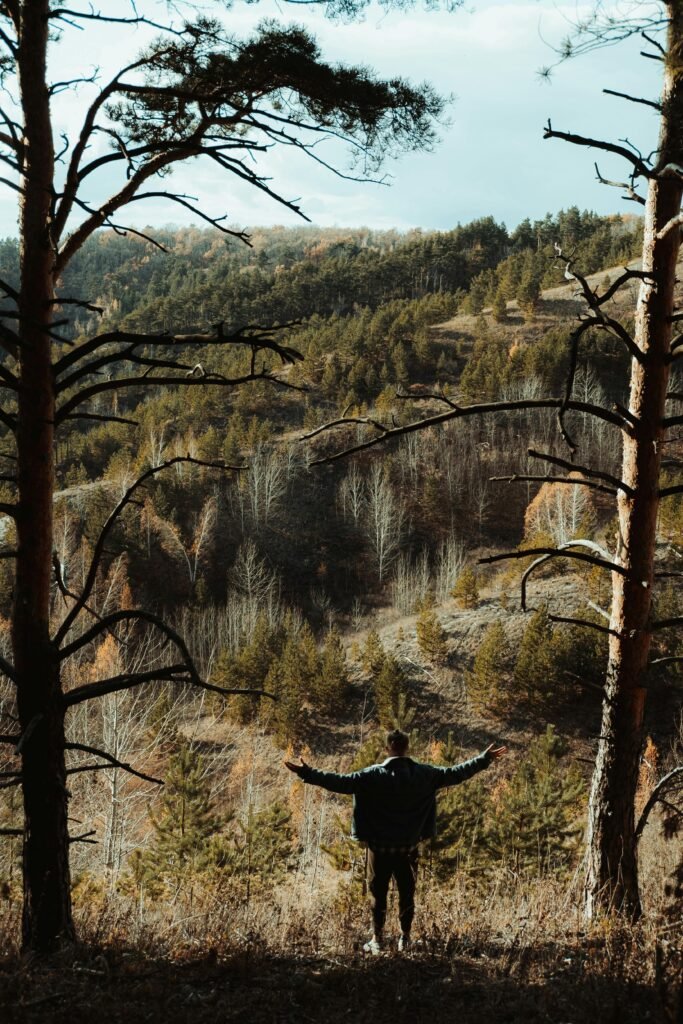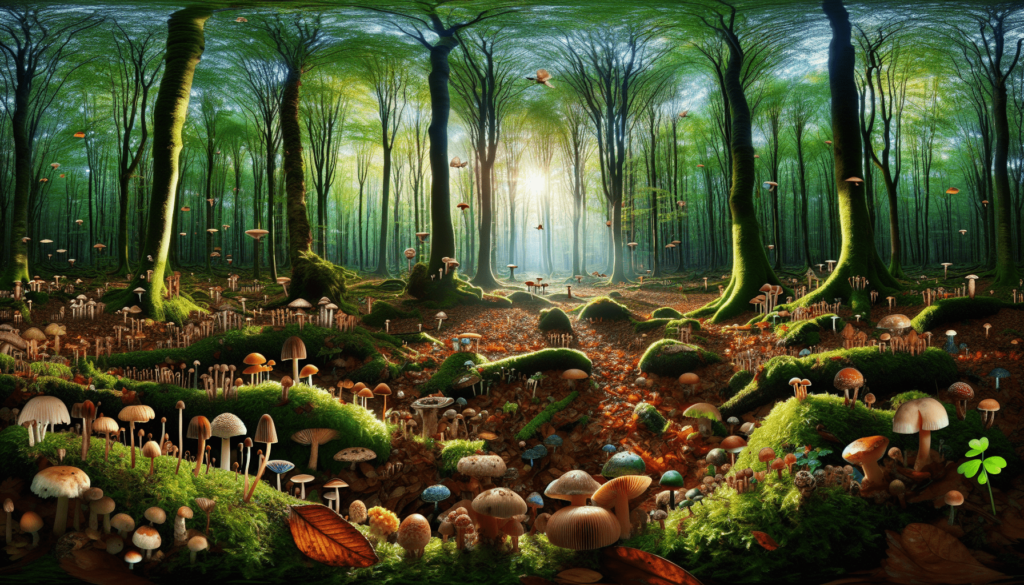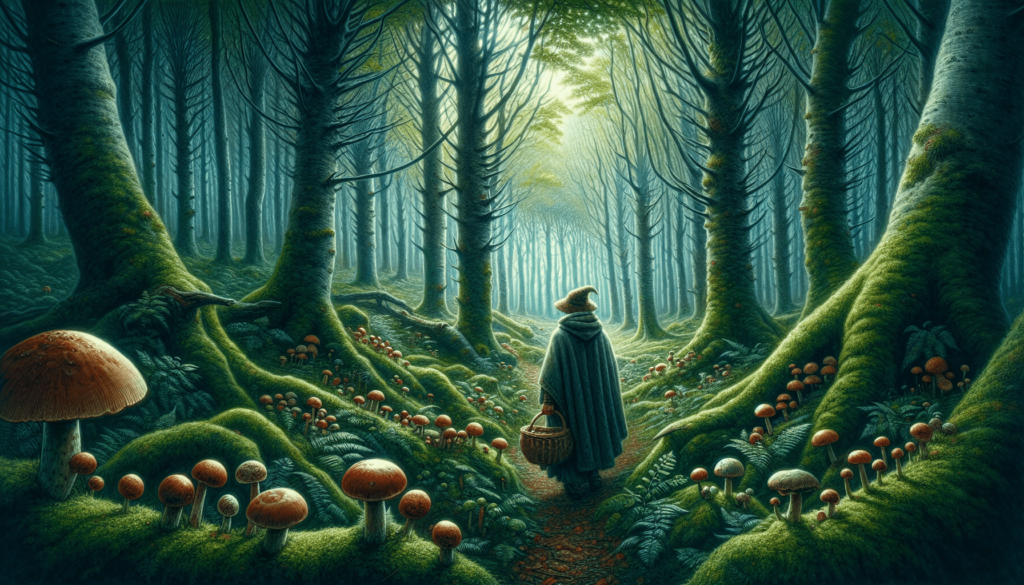Immerse yourself in the enchanting world of mushroom foraging as we explore the ancient woods of Ireland. In this captivating article, you can expect to discover regional spotlights and seasonal guides, ensuring you know the best times to embark on your foraging journey. With an emphasis on safety and ethics, you’ll gain valuable insights into responsible foraging practices and legal considerations. We’ll equip you with essential techniques and tools, while also exploring the culinary and medicinal uses of the diverse mushroom species found in Ireland. Prepare to be engrossed in engaging narratives and personal stories from experienced foragers, as you delve into the magical realm of mushroom foraging. Join us as we uncover the mysteries hidden within Ireland’s ancient woods and nurture your sense of wonder.
Overview of Ireland’s Ancient Woods
Introduction to Ireland’s ancient woodlands
Welcome to the enchanting world of Ireland’s ancient woodlands. These mystical forests, steeped in history and folklore, are home to an incredible diversity of plant and animal life, including a wide variety of mushrooms. Exploring these woodlands will not only provide you with a captivating adventure but also offer you the opportunity to forage for a bounty of mushrooms that are rich in flavor and medicinal properties.
Characteristics of ancient forests
Ireland’s ancient woodlands are characterized by their age and ecological importance. These forests have stood for centuries, creating a unique habitat for many species to thrive. Ancient trees, such as oak, beech, and yew, dominate the landscape, creating an awe-inspiring environment that transports you back in time. Lush undergrowth, moss-covered stones, and babbling brooks further add to the charm of these woodlands, making them a perfect setting for mushroom foraging.
Importance of these forests for mushroom foraging
Ireland’s ancient woodlands are a treasure trove for mushroom enthusiasts. The diverse range of tree species, coupled with the rich soil and damp climate, create the perfect conditions for mushrooms to flourish. From delicate chanterelles to robust porcini, these forests are home to an array of edible and medicinal mushroom species. Whether you are seeking mushrooms for culinary delights or exploring their potential health benefits, the ancient woods of Ireland are a forager’s paradise.
Foraging Locations in Ireland
Exploration of different woodlands in Ireland
Ireland is blessed with a multitude of woodlands that offer exceptional foraging opportunities. Each region boasts its own unique characteristics and mushroom species, providing a fascinating experience for mushroom enthusiasts. Whether you are exploring the rugged beauty of the west coast or immersing yourself in the history of the east, Ireland’s woodlands have something to offer for everyone.
Highlighting the best regions for mushroom foraging
While every woodland in Ireland has its own charm, certain regions stand out as prime locations for mushroom foraging. County Kerry, with its pristine national park and rugged terrain, offers a rich variety of mushrooms, including the elusive cep. The ancient oak forests of County Mayo are renowned for their abundance of chanterelles and boletes. In County Wicklow, you can discover a wealth of mushroom species while enjoying the breathtaking scenery of the Wicklow Mountains.
Specific locations within ancient woods
Within these regions lie specific woodlands that are particularly noteworthy for mushroom foraging. Killarney National Park in County Kerry is a favored destination, with its diverse habitats and extensive range of mushrooms. Glenveagh National Park in County Donegal is another popular location, known for its majestic oak trees and the potential to discover rare mushroom species. The mystical Glendalough Valley in County Wicklow is a haven for mushroom enthusiasts, with its ancient monastic ruins and fascinating fungi.

Seasonal Guide to Mushroom Foraging
Identification of the best times of year for foraging
Understanding the seasonal patterns of mushroom growth is crucial for successful foraging. In Ireland, the mushroom foraging season typically begins in late summer and continues through the autumn months. During this time, the moist and mild climate provides the ideal conditions for mushroom growth. However, certain species may appear earlier or later in the season, so it is important to stay attentive to the changing patterns of nature.
Explanation of mushroom growth patterns in Ireland
In Ireland, mushrooms undergo a fascinating growth process influenced by temperature, moisture, and other environmental factors. As the summer transitions into autumn, the increasing humidity and cooler temperatures stimulate the growth of fungi. The mushrooms emerge from the forest floor, transforming the woodlands into a treasure trove of earthly delights. It is during this time that both edible and medicinal mushrooms can be found in abundance.
Seasonal variations in mushroom species
The mushroom species you can find in Ireland’s ancient woodlands vary throughout the seasons, each with its own unique characteristics and flavors. In late summer and early autumn, you may come across the prized cep, also known as the penny bun, known for its rich and nutty taste. As the season progresses, the woodlands reveal a multitude of species, including the vibrant orange chanterelle, the delicate fairy ring mushroom, and the meaty porcini. Exploring the woodlands during each season will provide you with a diverse and ever-changing array of mushroom species to discover.
Safety and Ethics
Guidelines for safe mushroom identification
As with any foraging activity, it is crucial to prioritize safety when identifying mushrooms. While Ireland is home to many edible and medicinal mushrooms, there are also toxic species that can cause harm if consumed. It is important to educate yourself and become familiar with the key characteristics of edible mushrooms to ensure a safe foraging experience. Always consult reliable field guides, join local foraging groups, or seek the guidance of experienced foragers to enhance your mushroom identification skills.
Tips for responsible mushroom harvesting
Responsible mushroom foraging goes hand in hand with sustainable practices and conservation efforts. To minimize your impact on the woodland ecosystem, it is essential to follow certain guidelines. Only take what you need and leave the rest for others and wildlife. Always use a knife or scissors to cut mushrooms at the base, rather than pulling them from the ground. This allows the mycelium, the fungal network beneath the surface, to continue growing and producing more mushrooms in the future. Lastly, be mindful of your surroundings and avoid damaging other plant life or disturbing wildlife habitats.
Protecting the ecosystem and wildlife habitats
Foragers have a responsibility to protect the delicate balance of Ireland’s ancient woodlands and the creatures that call it home. The mushrooms play a vital role in the forest ecosystem, helping to decompose organic matter and recycling nutrients back into the soil. By practicing ethical foraging, we can ensure the continued vitality of these habitats and preserve the biodiversity that thrives within them. Let us be stewards of the land, treat it with respect, and leave no trace of our presence.

Legal Considerations
Understanding foraging regulations in Ireland
Before embarking on your mushroom foraging adventure in Ireland, it is important to familiarize yourself with the local regulations regarding foraging. While foraging for personal use is generally permitted, there may be specific rules and restrictions that vary by location. National parks, private lands, and protected areas may have their own guidelines, so it is important to research and comply with these regulations to ensure a legal and responsible foraging experience.
Permission requirements and permits
Certain areas may require permission or permits for foraging, particularly if they are privately owned or protected. It is recommended to reach out to the landowners or the relevant authorities to obtain any necessary permits or permissions before venturing into these woodlands. By doing so, you can ensure a harmonious experience while respecting the rights of those who manage the land.
Protected species and prohibited areas
As you explore Ireland’s ancient woodlands, be mindful of the protected species and prohibited areas. Some mushrooms may be protected due to their rarity or ecological importance, and it is essential not to disturb or harvest these species. Additionally, certain areas within the woodlands may be off-limits to foraging due to conservation efforts or pre-existing land management plans. Familiarize yourself with the specific regulations in each location to avoid any unintentional violations and to protect the fantastic biodiversity of these ancient woodlands.
Foraging Techniques
Tools and equipment for mushroom foraging
Equipping yourself with the necessary tools and equipment can greatly enhance your mushroom foraging experience. A reliable field guide is essential for identifying mushrooms and learning about their characteristics. Additionally, a sturdy basket or foraging bag will allow you to safely carry your finds, ensuring that mushrooms remain fresh and intact. Other useful tools include a knife or scissors for cleanly cutting mushrooms, a walking stick for stability, and a camera to capture the beauty of your discoveries.
Techniques for efficient and effective foraging
While mushroom foraging can be a serene and meditative experience, utilizing certain techniques can improve your efficiency and increase your chances of finding a bountiful harvest. Start by familiarizing yourself with the habitat preferences of different mushroom species to narrow down your search areas. Slowly navigate the woodland, observing the ground closely for any signs of mushrooms. Focus on areas with decomposing wood, fallen leaves, or moist soil, as these are often prime spots for mushroom growth. Don’t be afraid to get down on your hands and knees for a closer look – many mushrooms hide in the shadows!
Methods for preserving and storing mushrooms
Preserving and storing your mushroom bounty ensures that you can prolong the enjoyment of your foraged treasures. Start by cleaning the mushrooms gently with a soft brush or a damp cloth to remove any dirt or debris. Avoid washing mushrooms with water, as they can become waterlogged and lose their delicate flavor and texture. Depending on the species, you can choose to either cook and consume the mushrooms immediately or preserve them for later use. Methods such as drying, freezing, or pickling can lock in their flavors and extend their shelf life, allowing you to savor the taste of the woodlands throughout the year.

Culinary Uses of Irish Mushrooms
Exploration of traditional Irish mushroom recipes
Irish cuisine has long celebrated the flavors and versatility of mushrooms, incorporating them into a range of traditional dishes. From the iconic Irish breakfast fry-up featuring sautéed mushrooms to hearty mushroom stews and savory pies, mushrooms have been a staple in Irish kitchens. Traditional recipes highlight the natural flavors of the mushrooms and often pair them with other locally sourced ingredients, creating wholesome and comforting dishes that reflect the unique culinary heritage of Ireland.
Modern culinary applications of local mushrooms
In recent years, Irish chefs and food artisans have embraced the abundance of local mushrooms and showcased their versatility through modern culinary applications. Mushrooms are now being used in innovative ways, such as in vegetarian and vegan dishes, as meat substitutes, or as a key component in flavor-packed sauces and condiments. With their earthy flavors and unique textures, Irish mushrooms are adding depth and complexity to contemporary cuisine, pleasing both food enthusiasts and adventurous palates.
Unique flavors and textures of Irish mushroom species
One of the wonderful aspects of mushroom foraging in Ireland is the opportunity to discover a range of species with distinct flavors and textures. The earthy and nutty taste of the cep, the delicate and fruity notes of the chanterelle, and the meaty texture of the porcini are just a few examples of the diverse flavors that Irish mushrooms offer. Exploring these unique tastes will allow you to elevate your culinary creations and appreciate the incredible array of flavors that nature has to offer.
Medicinal Properties of Irish Mushrooms
Overview of traditional medicinal uses of mushrooms
Mushrooms have a long history of being used for their medicinal properties, and Ireland is no exception. The traditional Irish folk medicine practices have revered certain mushroom species for their healing properties. From boosting the immune system to aiding digestion and even being used as natural antibiotics, mushrooms have been a valuable component of traditional Irish remedies. The ancient woodlands of Ireland are a veritable pharmacy of medicinal mushrooms waiting to be explored.
Health benefits and therapeutic properties of Irish mushrooms
Scientific research has shed light on the health benefits and therapeutic properties of various Irish mushrooms. For example, the reishi mushroom has been found to possess powerful antioxidant and anti-inflammatory properties, making it a valuable ally in supporting overall well-being. The shiitake mushroom is known for its immune-boosting effects, while the chaga mushroom is prized for its potential anticancer and adaptogenic properties. Incorporating these mushrooms into your diet can provide you with a natural way to support your health and enhance your vitality.
Current scientific research on the medicinal value of these fungi
Ongoing scientific research continues to unlock the potential of Irish mushrooms as sources of invaluable medicinal compounds. Researchers are investigating the bioactive compounds and their mechanisms of action, exploring their potential in areas such as cancer treatment, cardiovascular health, and cognitive function. While these studies are still in progress, the findings thus far highlight the immense potential of Irish mushrooms to contribute to modern medicine and wellness practices. Ireland’s ancient woodlands hold secrets that could revolutionize healthcare in the future.

Exploring Irish Foraging Culture
Introduction to local foraging festivals and events
Foraging is deeply ingrained in Irish culture, with a rich history of gathering wild foods from ancient times to the present day. Throughout the year, Ireland plays host to various foraging festivals and events that celebrate the abundance of nature’s pantry. These gatherings bring together foragers, chefs, artisans, and nature enthusiasts from near and far to revel in the joys of foraging. From guided walks and workshops to cooking demonstrations and tasting sessions, these events create a vibrant tapestry of community and camaraderie.
Foraging communities and groups in Ireland
Foraging is often a communal and shared experience, and Ireland is home to several foraging communities and groups dedicated to the exploration of nature’s edible and medicinal offerings. These communities serve as a platform for knowledge sharing, skill development, and fostering connections among like-minded individuals. Joining these groups allows you to tap into a wealth of expertise, expand your understanding of mushrooms, and forge lasting friendships with fellow foragers.
Stories and experiences of Irish mushroom foragers
The foraging community in Ireland is teeming with stories and experiences of passionate mushroom foragers. These individuals have spent countless hours exploring the ancient woodlands, uncovering hidden treasures, and immersing themselves in the wonders of the natural world. Their stories, shared with equal parts enthusiasm and reverence, offer a glimpse into the magical and mystical realm of mushroom foraging in Ireland. From chance encounters with rare species to unforgettable moments of connection with nature, these stories ignite the curiosity and inspire others to embark on their own foraging adventures.
Conservation and Sustainability in Ancient Woodlands
Importance of preserving ancient forests
Preserving ancient woodlands is of paramount importance for the survival of not only mushrooms but also the countless plant and animal species that call these ecosystems home. These forests have irreplaceable ecological value, acting as carbon sinks, purifying the air we breathe, and supporting a complex and interconnected web of life. By protecting and conserving these ancient woods, we ensure their survival for future generations and the continued preservation of nature’s biodiversity.
Sustainable foraging practices in Ireland
Sustainability lies at the heart of responsible foraging practices in Ireland. By adopting sustainable foraging practices, foragers play a vital role in preserving the delicate balance of the woodland ecosystem. This includes harvesting mushrooms in a selective manner, leaving behind immature or rare species, and minimizing any disturbance to the surrounding habitat. Additionally, practicing ethical foraging involves spreading awareness about the importance of conservation and inspiring others to embrace sustainable practices, ensuring the longevity of Ireland’s ancient woodlands and the precious mushrooms they harbor.
Collaborative efforts for the conservation of mushrooms and their habitats
Conservation efforts in Ireland are not limited to individual actions but extend to collaborative initiatives that aim to protect mushrooms and their habitats on a larger scale. Conservation organizations, governmental bodies, and local communities in Ireland are working together to create protected areas, establish sustainable management plans, and raise awareness about the ecological importance of ancient woodlands. By joining hands and pooling resources, these collaborative efforts are helping to create a brighter future for Irish mushrooms and the ecosystems they rely on.
In conclusion, Ireland’s ancient woodlands offer a magical and captivating backdrop for mushroom foraging. From the lush forests of Kerry to the majestic woodlands of Mayo and the picturesque valleys of Wicklow, each region has its own unique charm and mushroom species waiting to be discovered. By practicing responsible foraging techniques, respecting the natural environment, and engaging in sustainable practices, we can ensure the preservation of these ancient forests for generations to come. So, put on your walking shoes, grab a basket, and embark on a journey of exploration and wonder in Ireland’s ancient woodlands. Happy foraging!

